The topic of the article will be the care of the Phalaenopsis orchid at home. Orchid flowers are extremely elegant, characterized by an unusual shape and extensive color diversity.
Novice growers would love to grow phalaenopsis at home, but they are hindered by the prospect of difficult care, so they prefercacti and other unpretentious plants.
I have a good news. Among orchids, there are species that are not very capricious in terms of home care and even a beginner grower can cope with their content. Among them, the Phalaenopsis orchid, characterized by long flowering and beautiful flowers.
Breeders have bred many types of phalaenopsis, which we will consider later. All of them are unpretentious in care and suitable for beginner gardeners. Some types of orchids have a pleasant aroma. Up to 40 flowers with a diameter of 3-15 centimeters are concentrated on one peduncle. The number and size of flowers depends on the branching and well-being of a home orchid.
Blooming orchids have bright flowers, the range of shades of which is wide. On the petals there are patterns, dots and spots that serve as an additional decoration. The leaves are characterized by diversity in terms of width, length and decoration in the form of spots and strokes.
Home Care Secrets

- Lighting and location. Phalaenopsis orchid is a photophilous plant. Keep the flowerpot with the plant on the windowsill. The north-western side is considered optimal. The orchid needs protection from sunlight, otherwise spots will appear on the leaves. In the summer, slightly shade the window glass, especially if the flower is on the south windowsill. When choosing a location, keep in mind that drafts weaken phalaenopsis and lead to pests and ailments.
- Temperature. Home orchid feels great indoors with an air temperature of 15-25 degrees. The plant tolerates even a temperature exceeding the mark of 30 degrees, but such a temperature regime will lead to the dropping of flowers. To stimulate flowering in the winter, keep the orchid for about two weeks in a room with a temperature of about 15 degrees.
- Air humidity. In order for the home orchid to grow and develop normally, keep the humidity in the room at 40 percent. In the summer, keep the flowerpot with the plant on a pallet filled with wet pebbles, otherwise phalaenopsis will drop the flowers. I do not advise you to constantly moisten the soil, if proper ventilation is not provided, excess moisture will lead to decay of the root system.
- Watering. It is recommended to water the orchid once a week, and in the summer, increase the number of waterings to two. Experienced gardeners prefer watering through a shower with soft water. There is another way. Dip the flowerpot with an orchid in a container of soft water for fifteen minutes so that the soil is saturated with moisture. Then put the pot on the pallet. Excess moisture will escape through drainage. Be sure to drain the water from the pan.
- Substrate. Can be purchased at the store or made by yourself. The main thing is to be moisture-resistant and light. Combine three parts of high-quality peat with three parts of crushed fern roots, add two parts of the earth and one part of small pine bark and charcoal.
- Top dressing. During the vegetative period, feed your home phalaenopsis orchid with nitrogen fertilizers after watering twice a month. Fertilizers for feeding can be done independently. The main thing is to observe the ratio of potassium, phosphorus and nitrogen. Look for the exact information on preparation of top dressing on subject sites.
- Transfer. Transplant Phalaenopsis once every 36 months. During this time, the soil loses its useful properties, becomes brittle and brittle, acquires a sour smell. Transplant after flowering. To extract the orchid from the old pot quickly and easily, immerse it in water for several minutes, and then, taking it under a power outlet, carefully remove it. After cleaning and washing the root system and removing the rotten roots, plant the orchid in a new pot with fresh substrate.
After reviewing the material, you are convinced that the Phalaenopsis orchid is unpretentious in care. Under optimal conditions, it pleases with wonderful flowering, which decorates the home and fills with aroma.
Types of Phalaenopsis

Phalaenopsis is an unpretentious and popular orchid. The genus is represented by 70 species that grow in the rainforests of Australia, the Philippines, Indonesia, New Guinea and are used in home floriculture.
A stem is considered a feature that does not branch, but slowly grows in length, giving several leaves a year. As part of flowering, the plant gradually unfolds, and the flowers retain their decorative qualities for several months. Phalaenopsis decorates the interior for a long time.
8 most popular types of phalaenopsis:
- Amabilis. In the wild, this species, which is used during crossbreeding, is found in Australia and the Philippines. The medium-sized orchids have fleshy, leathery, dark green elliptical leaves, the length and width of which are 50 and 12 cm, respectively. The inflorescence reaches 50 cm and consists of twenty flowers, with a diameter of up to ten centimeters. The flowers have a white color, a yellow or purple lip, a pleasant aroma.
- Schiller. The species resembles Amabilis, however, it is distinguished by variegated leaves. They are silver-gray above, and reddish below. Homeland - Philippines. The highlight is countless flowers. There have been cases when one peduncle contained about 180 flowers. A developed orchid blooms several times, remaining blooming for several months.
- Stewart. Filipino-origin orchid resembles the previous look in terms of leaf shade and vegetative characteristics, but differs in the pattern on the leaves. It has a branching peduncle covered with medium white flowers with red spots. Lip - yellow with spots of purple. In apartment conditions, it blooms in spring and autumn.
- Luddemann. A small orchid of this species is characterized by light green leaves in the shape of an ellipse and blooms in winter. On small peduncles, up to seven violet, pleasantly smelling flowers, with a diameter of 6 centimeters, are simultaneously located. The species has a white lip with yellow markings. A mature orchid blooms constantly and is easily propagated by “children” forming on peduncles. Ideal for people for whom floriculture is hobby.
- Giant. It is considered the largest, spectacular and most complex representative of the genus in culture. But this does not prevent him from winning at exhibition events. The orchid owes its name to huge leaves, the length of which reaches 60 cm. In addition to decorative qualities, it is easy to cross and suitable for creating hybrids. An adult plant has several peduncles, forming about a hundred fleshy flowers with a diameter of 5 cm. They have a sweetish citrus aroma, yellow color and red-brown spots.
- Pink. The smallest species in the family. Has dark green leaves up to 15 centimeters long. Up to fifteen small pink flowers, which bloom in turn, are based on a purple curved peduncle.It has a small, three-lobed lip, pink lateral lobes looking forward, with a white base and several purple lines. Medium ovate lobes with a brownish base and white tips. Anther pink with a long beak.
- Sander. A rare, expensive and beautiful view. It has green leaves with a colorful pattern. Drooping, long peduncles are the basis for placing rows of 50 flowers up to 6 centimeters in size. Flowers have a varied color.
- Horse. Orchid with green leaves came to us from Taiwan and the Philippines. It is characterized by a purple-violet peduncle, which is lengthened and covered with another portion of new flowers. Light pink in color with a diameter of about three centimeters.
I examined the main varieties of phalaenopsis orchids that are found in culture. If you want to expand your home garden with new flowers, get one of these types.
Phalaenopsis propagation
According to many beginner gardeners, orchid cultivation is the lot of craftsmen. But lovers can do this too, just collect more information about the pet. We are talking about plant species, the intricacies of care and methods of reproduction.
The topic of further discussion will be reproduction, as we considered other points. Propagate the home phalaenopsis orchid in three ways. I will describe them.
The first way - reproduction by children
This breeding technique is the simplest and most common. Apply it a month after flowering. The most suitable time for the procedure is from February to June.
Children appear on peduncles and at the base of the outlet. They wait until they take root, and only after that they are transplanted into a separate pot. There are two ways to do this.
- The first involves the separation of the baby, processing of sections with charcoal, drying during the day and subsequent planting in the ground, where they take root. Greenhouse conditions are suitable for this purpose.
- In a transparent plastic container, put a piece of foam with a hole, deepen a young shoot into it, and then fill it with water and cover. After the emergence of roots, Phalaenopsis transplant into the ground.
The second way - cuttings
- As soon as the orchid fades, using an alcohol-pruned pruner, cut the peduncle at the base and divide into several parts. In the center of each handle, a sleeping kidney should be present, and I advise the sections to be treated with carbon powder.
- To sprout cuttings, plant in a greenhouse in a moist sphagnum. The temperature in the greenhouse is 25 degrees. In such conditions, cuttings grow rapidly.
You can do differently. Place the cut flower stalk in water with minerals and place in a bright place. The main thing is that the rays of the sun do not fall on the stalk. In such conditions, sleeping kidneys will quickly wake up and the children will release.
The third way - dividing the outlet
- Using a sterile tool, be it a knife or a pruner, cut off the top of the orchid along with several leaves and aerial roots. Treat all sections with ash, and plant the shoot in a pot.
- It should contain a mixture of fresh moss and pine bark. The bark must be dry, otherwise excess moisture will cause mold. Initially, confine yourself to small dishes, and as the root system develops, take a more spacious one.
- From this moment, the new elite needs care. As for the mother plant, it will release lateral buds from which young shoots will appear.
Phalaenopsis propagates as simple as dieffenbachia and any other ornamental plant. If you want to breed an entire family of orchids at home, the techniques described will help. If at first you make mistakes, everything will work out perfectly with experience.
Phalaenopsis breeding: problems, pests, diseases

Many gardeners who grow orchids have problems. In this case, the plant independently signals this.If the leaves droop, change color or become stained, then you are not properly caring for the phalaenopsis.
- You can track orchid problems by leaves. The first symptom of the suffering of the plant is considered a color change. If they are pale or covered with plaque, there is an excess of light in the room.
- In conditions of insufficient lighting, a home orchid blooms poorly, the width of the leaves decreases and the luster disappears. If the color of the leaves has lost saturation, the plant is undernourished.
- Constant waterlogging along with drafts leads to the appearance of blackened leaf tips. As for fading leaves, it indicates that the orchid is thirsty or tormented by pests.
- If the phalaenopsis is improperly looked after, it will be struck by pests: scale insects, thrips, aphids and mealybugs. In this case, rinse the orchid with water, gently wipe with a cloth, treat with pesticides.
- As for diseases, their list is represented by rot and the appearance of brown spots. To solve the problem, cut the affected areas and treat them with special chemistry. If the plant is badly damaged, discard. During these operations, use a tool treated with alcohol or burned with fire.
I hope the story does not alert you. Home Phalaenopsis orchid lives in any city apartment more successfully than many other indoor flowers, among which croton. It is easy to grow and undemanding to care for. If the soul longs for true beauty, make sure phalaenopsis appears in the home flower gallery.










